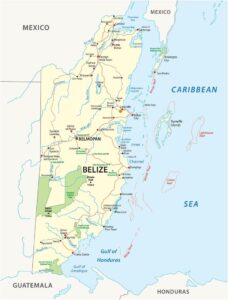Over the centuries, the territorial boundaries of Belize have evolved through a complex and contentious historical narrative. You might wonder why numerous maps depict the border between Belize and Guatemala as dotted, a visual indicator of a long-standing territorial dispute that runs deep within the fabric of these nations. This enduring conflict originates from historical claims made by Guatemala, which has persistently contested Belize’s sovereignty since it achieved independence. The potential for international tension remains substantial, as both countries actively engage in diplomatic dialogues aimed at resolving this border issue. Delving into this geopolitical enigma exposes the intricate challenges surrounding national borders in Central America, where colonial legacies and notions of territorial integrity intersect in potentially volatile ways.
Delving into the Historical Claims Behind the Belize-Guatemala Dispute
The persistent territorial conflict between Belize and Guatemala can be traced back to intricate historical and colonial legacies that have shaped their relationship. This dispute finds its roots in the colonial era when territorial boundaries were frequently ambiguous and open to varying interpretations. The unresolved border issue has endured through the centuries, perpetuating continuous tension between these neighbouring nations and influencing their diplomatic interactions.

Gaining Insight into Guatemala’s Long-standing Territorial Claims
Primarily, Guatemala has consistently upheld a historical claim of territorial rights over Belize, which is deeply rooted in the Spanish colonial administrative boundaries. It may come as a surprise that Guatemala perceives Belize as part of its original territorial inheritance from the Spanish Empire, thus challenging the modern borders that were delineated during the British colonial period. This historical context continues to invigorate Guatemala’s claims and complicate the issue of sovereignty.
Investigating the Implications of Historical Borders
Since the colonial era, these disputed boundaries have given rise to significant geopolitical challenges for both nations involved. You can observe how undefined border regions foster potential for conflict and diplomatic tensions, affecting local communities and notions of national sovereignty. Grasping the complexities of the border dispute unveils intricate layers of historical, legal, and territorial dynamics. The implications stretch beyond mere geographical delineations, encompassing economic, cultural, and security risks. The ongoing conflict holds substantial ramifications for regional stability, international law, and the prospects for future negotiations between Belize and Guatemala.
The Importance of the Dotted Line on Maps
When examining maps, you may notice a distinctive feature: a dotted boundary line between Belize and Guatemala, symbolising an unresolved territorial dispute that has persisted for decades. This unique cartographic representation highlights a complex geopolitical challenge, where the precise border remains undefined and fiercely contested. The dotted line serves as a symbol of the ongoing diplomatic tensions and the unresolved territorial claims that have characterised the relationship between these two Central American nations for many years.
International Recognition Amidst the Unresolved Border Dispute
In the realm of international relations, Belize stands as a sovereign entity with an acknowledged global presence; however, the disputed border with Guatemala presents a nuanced geopolitical scenario. You might find it intriguing that even though Belize attained independence in 1981, Guatemala has historically questioned its territorial integrity. The dotted line represents not only geographical uncertainty but also an ongoing diplomatic negotiation that continually influences regional relations and perceptions.
The Diplomatic Weight of the Dotted Line
Beyond its representation on maps, the dotted line functions as a significant diplomatic emblem. You can interpret it as a visual representation of unresolved territorial claims, signalling to the international community the intricate negotiations between Belize and Guatemala. This distinctive border marking conveys the ongoing dialogue and the potential for peaceful resolution of the conflict. However, the dotted line embodies more than a mere cartographic curiosity; it stands as a delicate diplomatic instrument that helps avert potential military escalation while maintaining an open channel for negotiation.
This line operates as a strategic buffer, enabling both nations to uphold diplomatic relations and work towards a conceivable future resolution. Its existence exemplifies how international borders can be managed through peaceful means, signifying a sophisticated approach to territorial disputes that prioritises dialogue over confrontation.

Understanding Key Conflicts and Diplomatic Agreements Between Belize and Guatemala
The territorial disputes between Belize and Guatemala are deeply ingrained in history, characterised by complex diplomatic tensions and unresolved boundary claims. You’ll uncover that the ongoing disagreement revolves around competing interpretations of colonial-era treaties and the notion of territorial sovereignty. This dispute carries extensive implications for both nations, involving potential land ownership challenges and regional geopolitical dynamics that continue to shape their interactions.
Assessing the Impact of the 1859 Treaty and Subsequent Developments
Prior to the signing of the 1859 treaty between Britain and Guatemala, territorial boundaries within the region were ambiguous and fiercely contested. It’s essential to recognise that this agreement aimed to delineate clear borders; however, subsequent interpretations led to ongoing disputes. Guatemala persistently challenges the validity of the treaty, asserting that Britain failed to fulfil certain commitments related to infrastructure development, which has become a critical point of contention in their territorial disagreement.
International Court of Justice Involvement and Recent Diplomatic Efforts
Recent diplomatic initiatives have centred on resolving the protracted border dispute via international legal frameworks. You’ll note that both countries have agreed to present their case to the International Court of Justice (ICJ) for a binding resolution. This strategy signifies a considerable step towards peaceful conflict resolution and the potential normalisation of bilateral relations.
Alongside the ICJ proceedings, it is crucial to recognise the intricate diplomatic negotiations that have unfolded. The potential referendum in both nations to validate the ICJ’s decision represents a distinctive method for addressing territorial disputes. Your understanding of this process underscores the delicate diplomatic efforts aimed at maintaining regional stability and resolving historical territorial claims through peaceful, internationally accepted mechanisms.
Grasping the Current Situation and Travel Considerations
Many travellers are captivated by Belize’s distinctive border configuration with Guatemala. The ongoing territorial dispute has created a complicated geopolitical landscape that influences travel and border crossings. Despite the existing tensions, tourists continue to journey to both nations, navigating the delicate diplomatic situation while being mindful of international boundaries and local regulations.
Essential Guidelines for Safely Crossing the Border
When planning international travel to Belize, it’s vital to prepare meticulously and consider these important guidelines:
- Ensure you possess a valid passport and any necessary travel documentation
- Check the current status of diplomatic relations prior to commencing your journey
- Acquire suitable travel insurance for your trip
- Stay informed about border crossing procedures to avoid complications
The most crucial aspect is to maintain awareness of your surroundings and adhere to local regulations to ensure a hassle-free travel experience.
Community Perspectives and Local Sentiments Regarding the Dispute
At the heart of the border dispute lie deep-rooted historical tensions and intricate cultural dynamics. Communities located near the border feel the direct impacts of the dispute, with generational memories of conflict profoundly influencing their perspectives. Residents often navigate a delicate balance between national pride and a desire for peaceful coexistence, illuminating the human dimension in this geopolitical issue.
Acquiring Deeper Insights into Community Dynamics
To truly comprehend the local perspective, you should explore the nuanced landscape of cultural identity. You’ll discover that border communities have developed unique survival strategies, blending resilience with diplomatic pragmatism. Indigenous groups, in particular, play a crucial role in preserving cross-border relationships, often transcending official diplomatic tensions through grassroots connections and shared cultural experiences, thereby fostering a sense of unity amidst conflict.

Anticipating Future Implications of the Belize-Guatemala Border Dispute
Despite the ongoing territorial dispute, there exists the potential for significant geopolitical shifts. The unresolved border issue between Belize and Guatemala continues to cultivate tension, with ramifications that could reshape diplomatic relations in Central America. You might observe that resolving this dispute could have far-reaching impacts on regional stability, economic collaboration, and the international perceptions of both nations.
Maintaining Dialogue Between Belize and Guatemala
Dialogue serves as the primary mechanism for addressing the territorial disagreement. You will discover that both countries have engaged in diplomatic negotiations, striving for peaceful resolutions through international platforms such as the Organization of American States (OAS). These discussions exemplify a commitment to avoiding military confrontation and finding a mutually acceptable solution to their long-standing border dispute, emphasising the critical role of dialogue in conflict resolution.
Exploring Potential Pathways Towards Resolution
Above all, it is important to recognise that multiple strategies exist for resolving the border conflict. International mediation and bilateral negotiations present potential avenues for progress. You might envision approaches such as joint territorial management, referendums, or interventions from international courts as viable methods to effectively address the dispute.
The implications of resolving the conflict extend far beyond simple border demarcation. You will find that successful negotiations could unlock considerable economic opportunities for both Belize and Guatemala. Potential benefits could encompass enhanced trade, improved cross-border cooperation, and increased foreign investment. The most transformative outcome would be the establishment of permanent territorial sovereignty, which could dramatically alleviate regional tensions and promote long-term stability in Central America.
Understanding the Regional Dynamics of the Belize-Guatemala Conflict
Unlike other border disputes in Central America, the Belize-Guatemala territorial conflict is steeped in deep historical complexities that have significantly shaped regional geopolitical interactions. You’ll find that this longstanding disagreement reflects broader patterns of territorial tension, involving colonial legacies, post-independence territorial claims, and intricate diplomatic negotiations that have profoundly influenced the political landscape of the region.
Assessing the Impact of the Dispute on Central American Relations
After decades of territorial disputes, you can observe how this conflict has strained diplomatic relationships between Belize and Guatemala. The ongoing tension has periodically disrupted regional cooperation, creating challenges for economic integration and mutual understanding within the broader Central American community.
The Role of International Organizations in Mediation
With diplomatic mediation playing a pivotal role, international organisations have actively participated in efforts to resolve the border dispute. You’ll notice that entities like the Organization of American States (OAS) have been instrumental in facilitating dialogue and proposing practical resolution strategies.
A comprehensive network of international organisations has been strategically involved in addressing the Belize-Guatemala border dispute. The United Nations, OAS, and various diplomatic channels have worked tirelessly to avert escalation, offering mediation services and promoting peaceful negotiation. You’ll appreciate how these organisations have contributed to maintaining stability, providing a structured approach to resolving territorial disagreements and mitigating potential military confrontations.
Reflecting on the Complexities of the Belize-Guatemala Border Dispute
Weaving together the intricate threads of Belize’s territorial history, you can perceive how the nation’s border with Guatemala remains a testament to unresolved colonial legacies. As you delve into this geopolitical puzzle, you’ll understand that the dotted border signifies more than a mere cartographic curiosity; it embodies ongoing diplomatic negotiations and historical tensions. Your understanding of this dispute reveals the intricate challenges facing post-colonial states, wherein territorial boundaries continue to ignite international dialogue. The unresolved status underscores the delicate balance between historical claims and modern diplomatic resolutions, inviting you to appreciate the nuanced complexity of international border disputes.

Your Questions Answered: Frequently Asked Questions about the Belize-Guatemala Border Dispute
What causes Belize's dotted border with Guatemala?
The dotted border signifies a longstanding territorial dispute between Belize and Guatemala, originating from conflicts dating back to the colonial era. Spain initially claimed the territory, and after Belize gained independence from Britain in 1981, Guatemala continued to assert its territorial claims, leading to an undefined border demarcation illustrated by the characteristic dotted line on maps.
Has the border dispute between Belize and Guatemala been resolved?
The dispute remains partially unresolved; however, significant progress has been made. In 2019, both countries agreed to submit the territorial disagreement to the International Court of Justice (ICJ) for a binding resolution. A referendum in both nations endorsed this approach, indicating a diplomatic pathway towards definitively settling the border controversy.
What are the historical origins of the border conflict between Belize and Guatemala?
The conflict dates back to the 1859 treaty between Britain and Guatemala, which promised infrastructure development in exchange for territorial recognition. When Britain failed to fully meet these commitments, Guatemala began challenging Belize’s territorial integrity. This historical misunderstanding has perpetuated decades of tension, with Guatemala maintaining claims over approximately 53% of Belize’s current national territory.
The Article Why Is Belize’s Border Dotted? Exploring the Guatemala Dispute appeared first on Belize Travel Guide
The Article Belize’s Border Dotted: Unraveling the Guatemala Dispute Was Found On https://limitsofstrategy.com

